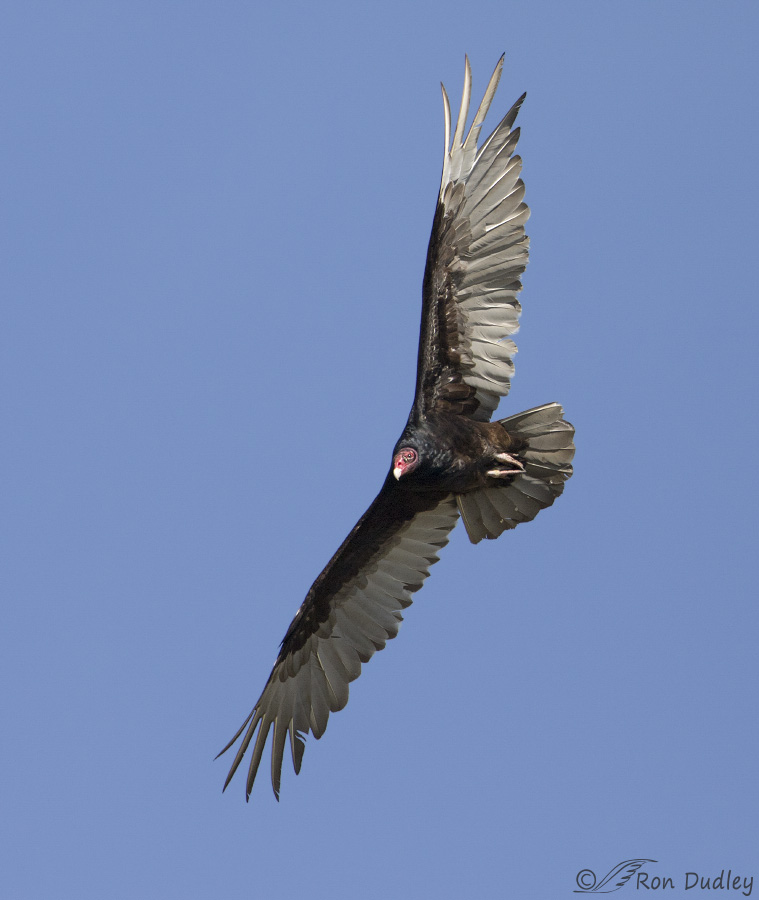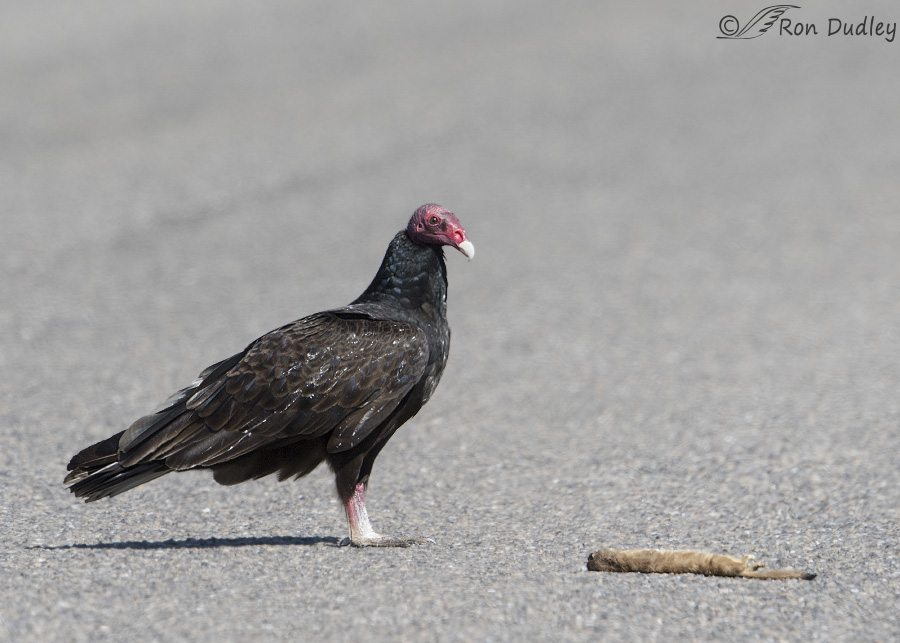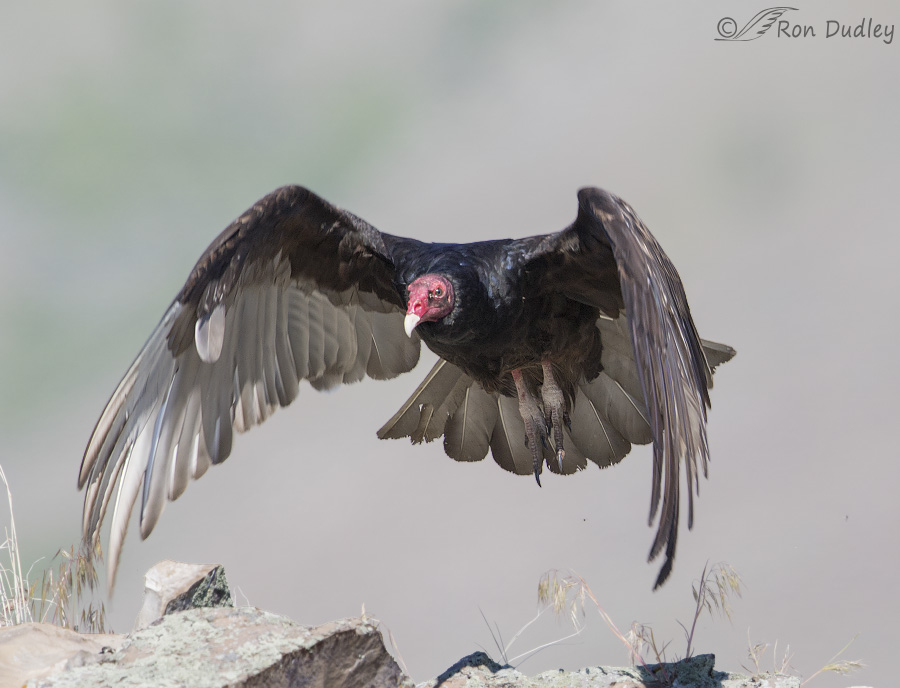These recent images illustrate three favorite pastimes of Turkey Vultures.
The flight mode of Turkey Vultures is almost entirely gliding and soaring and they do it effortlessly for hours on end. Birds of North America Online reports their soaring abilities to be “vastly superior to those of Buteo hawks”. I often watch them through my lens as they use mountain updrafts for lift and circle endlessly on them with very little effort.
While I’m watching them in flight I don’t often click my shutter because their dark plumage is usually backlit but yesterday morning I caught this one in a near-vertical bank that put decent light on its ventral surfaces and I think the direct eye contact with the red head outlined in black helps to draw the viewer in.
Understandably I have mixed emotions about this photo, also from yesterday morning. The setting is an ugly road, the soiled vulture is far from aesthetically appealing and the roadkill is one of my very favorite critters – a Long-tailed Weasel. Vultures are often seen waiting at carcasses because they cannot open thick skin of larger mammals so usually they have to wait until the carcass is putrid or is opened by mammals. But I doubt they’d have trouble opening a carcass this small so I’m not sure why the vulture just stood there watching the weasel and made no attempt to eat while I was there. Perhaps my presence made it nervous.
I’m quite sure the weasel was very recently killed because I didn’t see it about a half-hour earlier when I slowly passed the other way on the road.
Another favorite pastime of vultures is to stymie my attempts at photographing them well at takeoff. This bird (photographed three days ago in the same area as the earlier images) was really too close to me for takeoff shots so when it launched in my direction I cut off wings in all but one of over a dozen photos in the burst. I like the curve of the wings, the fanned tail and the intimacy provided by the head-on approach at close range.
Another problem with photographing Turkey Vultures is the typically high contrast between their almost black plumage and the rocks, vegetation or soil that may be in the setting and that’s exactly what happened here. In this case to get the dark vulture exposed correctly the rocks in the foreground were significantly overexposed and highly distracting in their brightness. So during processing I selectively brought down the exposure of the rocks by using a “levels adjustment” in Photoshop – something I don’t often do.
Very sharp eyes may notice a small remnant of that adjustment that I wasn’t quite able to get rid of but seeing it with my old eyes requires serious pixel-peeping so it really doesn’t bother me. I much prefer that tiny flaw over the very bright rocks.
Ron





I got to the comics page late today, but May 23rd’s Argyle Sweater was timely. http://theargylesweater.com
Timely indeed. Leftunders, I like that!
LOVE it Marty! Timely indeed!
Beautiful Photos! And good luck with the toothache!
Such a common bird, but such a difficult subject to photograph. But you did it – 3 times in this post: detail in the dark body and wings, good look at the head, and a catch light. I hope the tooth situation is improving.
Love the vulture. A necessary function performed well. If I could ‘ almost effortlessly’ soar and glide I would happily take on their job.
I hope your dental pain recedes quickly. Very, very quickly.
The (very small) “flaw” is where the curve of the rock meets the background directly below the right wingtip. If you look carefully you’ll see a small thin dark line on the interface of the rock and background that shouldn’t be there (it isn’t in the RAW file). It was caused by imperfect masking when I applied the levels adjustment to decrease the exposure of the rock. I tried to get it right… but I didn’t.
Sorry, but once again I won’t be responding to individual comments. I had a tooth pulled earlier today and it didn’t go well. I’m in an unusual amount of pain and discomfort and I’m not thinking particularly straight. Hopefully I can sleep it off…
I’m sorry about your tooth. Here’s hoping that you feel better very, very soon!
Also sorry about your tooth!! I know what you are going through! Just remember were all pulling for you!
Ah, well now I see it, but I really had to enlarge the image to see it. So no worries about this “flaw,” it’s certainly not fatal! 😁
I, too, wish you relief from your pain … and hope you’re sound asleep as I write this!
Hope you’re doing better – not fun for sure. 🙁
So sorry you’re hurting Ron. I’ve been down that dental road multiple times and it never gets easier. It just hurts. Relax, enjoy the pain killers (yeah, I know, but try) and I hope you’re feeling MUCH better tomorrow. Gentle HUGS!
My painkiller is limited to Advil. He offered something stronger but I didn’t think I’d need it. In hindsight I should have jumped at the chance.
I’m sorry Ron. In future, always choose to have the option. You don’t have to use it if it’s not necessary, but having choices is always a good thing! That’s from the perspective of someone who deals with chronic pain every day, some days more than others. But you know that now.
Your post made me wonder if the “buzzards” still return to Hinckley, Ohio on March 15, so I Goggled the event and yes, their timing and record (60 years now, since they started recording the event) remain intact.
I don’t know about any remnant flaw but that last photo is really amazing. Love the arc of the wings and the contrast of that bright red head against jet black feathers. And even though I’ve seen our resident TUVU (“Handsome”) up close and personal at the Ojai Raptor Center, I don’t think it’s ever registered with me how huge those feet and talons talons are! Very cool view.
One mans concern is another mans awe, delight, or “Oh man if I only could get shots like that!!
Nice shots of a bird we see almost every day, soaring in the summer, but too far away for my lens to accurately capture. I’m saving my shackles, but probably my bank loan would be a lot quicker! : )
However, I will admit that from time to time we see a TV fly close over our field/meadow/marsh seemingly looking closely, but than flying off. I always suspect it either smells/sees something that peeks its curiosity.
Vultures do a great service, generally we humans tend to forget that about them!
Around here is arguably the Turkey Vulture Capitol of the Universe. Leesburg, VA had a program a few years ago to spend hundreds of dollars on flash/bang fireworks to dissuade them from nesting in town. Nothing matches the beady-eyed stare a buzzard can give you if you drive slowly past an infested road kill!
They are superb fliers, though, and they cruise through here constantly at tree top level.
Once again, OH WOW! What a lovely series of photos. I kinda hate the second one simply because the vulture is firmly within the danger zone! I want him to grab that weasel and take it off road–immediately if not sooner!!!
I just love vultures. They’re way cool and there are a bunch of them (turkey vultures) living around my place in Arizona. One day last week, one challenged my year-old Brittany to a duel. Flying low to the ground, skimming the tops of the weeds only occasionally flapping his/her wings, the vulture enticed Cody to chase him/her. Since Cody is a bird dog just learning what kinds of birds he should be chasing (instead of butterflies and such), Cody took the challenge and very nearly caught the vulture’s tail! If he’d been successful, the question then would have been “now what are you going to DO with it?” I’m delighted that Cody failed, but he was oh so close–within less than a foot!
Of COURSE, I don’t have a photo of the event. That’s YOUR job 😉
I agree that vultures are needed, and glad they are around to clean up……however oh my, that head, not a pretty sight for sure. For me anyway…..but great shots Ron of this odd looking bird!
Great light on these turkey vultures Ron. You did a great job showing their true colors and the details on them.
Sad to see a dead long-tailed weasel.
Your observation of the time the weasel carcass remained on the road reminds me of one of my favorite books, “Consider a Spherical Cow: A Course in Environmental Problem Solving”, by John Harte.
This book teaches the methods Enrico Fermi used to estimate order of magnitude estimates, or “back of the envelope” calculations.
One of the problems in the book asks: “I was driving down a lonely road going 60 mph for 2 hours, I saw three cars pass me the other direction. I saw 2 dead jackrabbits on the road. I also saw a few ravens flying. What is the rabbit population density in the area?” (this is not verbatim as I am having trouble finding my copy of the book…).
The first shot is spectacular with that wingspan, the white underside of the wings, that red head, and the catchlight in the eye! Wow! Even with all your disclaimers, I quite like the second shot. It almost looks like he’s striking a pose just for you. The last shot is pretty cool too. The wing position is so neat!
I’d say you’ve achieved the trifecta of Ron doing what Ron does: taking fabulous photographs! 🙂
This is an interesting series…especially like the first and last images…although I greatly respect and value vultures for the service they provide, the farther away they are, the better I like them…they are beautiful and graceful when they are soaring…Close up, not so much……I tried to see the “flaw”, but failed…(Inspite of your claim of poor eyesight, you seem to have eagle eyes when it comes to finding perceived “flaws”)…,
Help! I give up…where’s the flaw?
Help! I give up. Where’s the flaw?
I agree Patty, tried to find it, but couldn’t.
Am I correct in understanding that the head of the vulture is bald for hygienic reasons? With head first feasting it must get messy. Do they bathe like other birds? I love all of these shots.
Interesting what the three favorite pastimes of Turkey Vultures are… These photos show off very well what the plumage looks like. I’m left in the dust with noticing what your adjustment remnant is. Maybe old eyes are a blessing?
Once upon a time in northern Arizona, I looked out my kitchen window to see the corpse of the very ancient skunk whose live “presence “had been odiferous and obvious ever since I moved in next to the brushy
hillside. I assumed he’d probably died of old age, and I fretted all day at work as to how I could get rid of his body…late that afternoon, I looked out that same window to see 2 vultures busily at work,
their red faces illuminated in the western light . The next morning, the only clue left of their dinner was a white furry strip–who knows why they didn’t take that for dessert ? I was MOST GRATEFUL
for their place in “the web” !
Gorgeous shots, Ron! 🙂 Any critter that’s black is tough to capture well. They are the clean up crew for sure even if it’s a bit “gross” at times. 🙂
Thanks, Judy. Without vultures this area of northern Utah where I often shoot would be littered with corpses. They do us a great service.